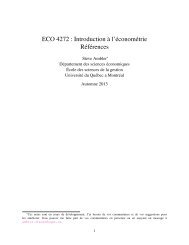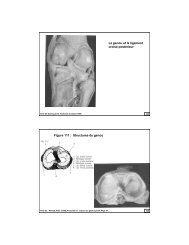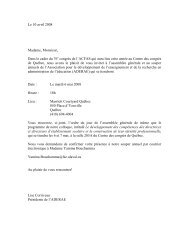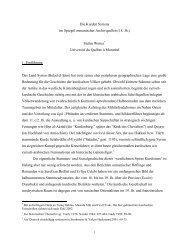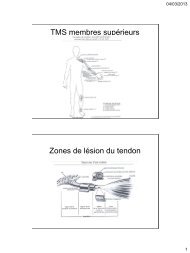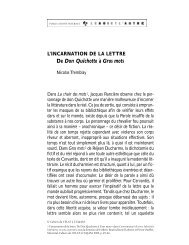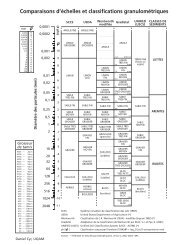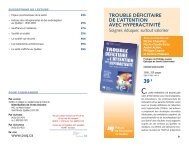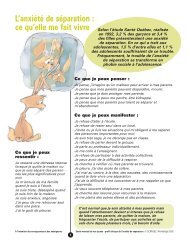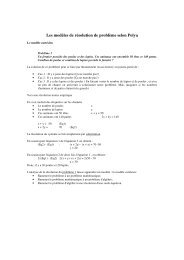Télécharger la revue en format "pdf". - UQAM
Télécharger la revue en format "pdf". - UQAM
Télécharger la revue en format "pdf". - UQAM
Create successful ePaper yourself
Turn your PDF publications into a flip-book with our unique Google optimized e-Paper software.
88 Revue sexologique / Sexological Review<br />
For homosexual partners, the data suggest that for male<br />
respond<strong>en</strong>ts, homosexual contacts are twice as likely to be non-IDUs.<br />
This finding is consist<strong>en</strong>t with the epidemic in Sydney spreading from<br />
homosexually active m<strong>en</strong> to IDUs. It may also provide one<br />
exp<strong>la</strong>nation as to why the growth of the HIV epidemic in its first t<strong>en</strong><br />
years in Australia has be<strong>en</strong> slower in IDUs compared with that in<br />
other developing countries. A corol<strong>la</strong>ry of this is that there will be<br />
pot<strong>en</strong>tially greater spread of HIV in non-IDU heterosexual people<br />
wh<strong>en</strong> the pool of infected IDUs <strong>en</strong><strong>la</strong>rges. For female respond<strong>en</strong>ts, the<br />
t<strong>en</strong>d<strong>en</strong>cy is for the converse to occur (i.e., for lesbian contacts to be<br />
more likely with other IDU wom<strong>en</strong>). These data on same-sex contacts<br />
(13.3% for males, 12.2% for females for the <strong>la</strong>st contact) are higher<br />
than g<strong>en</strong>eral popu<strong>la</strong>tion estima tes of the number of m<strong>en</strong> in the<br />
g<strong>en</strong>eral Australian popu<strong>la</strong>tion who report same-sex contact with<br />
other m<strong>en</strong> in their lifetime (11.2%; 6.1% in the past year: Ross, 1988)<br />
and ev<strong>en</strong> higher for wom<strong>en</strong> who reported sex with another woman<br />
in their lifetime (4.6%; 2.7% in the past year in the same study).<br />
It must be emphasized that the id<strong>en</strong>tification of the sexual<br />
ori<strong>en</strong>tation of partners (where this is known by the respond<strong>en</strong>t) is<br />
likely to be based on admission of self-id<strong>en</strong>tity of the partner or sore<br />
other form of disclosure rather than by observation of their sexual<br />
behaviour, and thus same-g<strong>en</strong>der sexual contacts with appar<strong>en</strong>tly<br />
heterosexual partners is reported. This could also be a function of<br />
error variance, and thus these data, particu<strong>la</strong>rly those where small<br />
perc<strong>en</strong>tages are reported, should be interpreted with caution. Further,<br />
because of the stigmatized nature of homosexual (and to a lesser<br />
ext<strong>en</strong>t bisexual) contacts, the t<strong>en</strong>d<strong>en</strong>cy is probably toward under<br />
reporting. Nevertheless, it is of interest that around three-quarters of<br />
the sample were able to give suffici<strong>en</strong>t detail about sexual partners to<br />
make an assessm<strong>en</strong>t of possible partner involvem<strong>en</strong>t in pot<strong>en</strong>tially<br />
risky sexual activities.<br />
In estimating level of risk in sexual contacts of IDUs, a critical<br />
variable is whether the nature of the sexual contact was such as to<br />
pot<strong>en</strong>tially transmit HIV. We have reported that for this sample,<br />
betwe<strong>en</strong> a quarter and a third of the time heterosexual m<strong>en</strong> use<br />
condoms for vaginal sex with aH partners, and betwe<strong>en</strong> a quarter and<br />
a half of the time heterosexual wom<strong>en</strong> use condoms for vaginal sex<br />
with aH partners (Ross, Wodak & Gold, 1992), with there being lower<br />
proportions for regu<strong>la</strong>r partners and higher proportions for<br />
homosexual and to a lesser ext<strong>en</strong>t bisexual m<strong>en</strong> for p<strong>en</strong>etrative sex.



